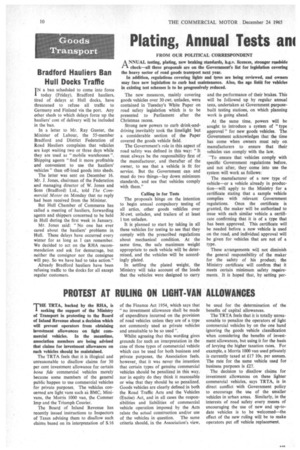PROTEST AT RULING ON LIGHT-VAN ALLOWANCES
Page 12

If you've noticed an error in this article please click here to report it so we can fix it.
THE TRTA, backed by the RHA, is I seeking the support of the Ministry of Transport in protesting to the Board of Inland Revenue about a decision which will prevent operators from obtaining investment allowances on light commercial vehicles. In the meantime, association members are being advised that claims for investment allowances on such vehicles should be maintained.
The TRTA feels that it is illogical and unreasonable to disallow claims for 30 per cent investment allowance for certain bona fide commercial vehicles merely because some members of the general public happen to use commercial vehicles for private purposes. The vehicles concerned are light vans such ai BMC, Minivans, the Morris 1000 van, the Commer Imp and the Triumph Courier.
The Board of Inland Revenue has recently issued instructions to Inspectors of Taxes advising them to disallow such claims based on its interpretation of S.16 of the Finance Act 1954, which says that "no investment allowance shall be made of expenditure incurred on the provision of road vehicles unless they are of a type not commonly used as private vehicles and unsuitable to be so used ".
Whilst agreeing that this wording gives grounds for such an interpretation in the case of those types of commercial vehicle which can be used for both business and private purposes, the Association feels, however, that it was never the intention that certain types of genuine commercial vehicles should be penalized in this way, nor in equity do they think it reasonable or wise that they should be so penalized. Goods vehicles are clearly defined in both the Road Traffic Acts and the Vehicles (Excise) Act, and in all cases the responsibilities and liabilities of commercial vehicle operation imposed by the Acts relate the actual construction and/or use of the vehicles in question. The same criteria should, in the Association's view, be used for the determination of the benefits of capital allowances.
The TRTA feels that it is totally unreasonable to penalize the operators of light commercial vehicles by on the one hand ignoring the goods vehicle classification when considering the benefits of investment allowances, but using it for the basis of levying the higher taxation rates. For example, a Morris 1000 van used privately is currently taxed at i17 10s. per annum. The rate for the same vehicle used for business purposes is L27.
The decision to disallow claims for investment allowances on these lighter commercial vehicles, says TRTA, is in direct conflict with Government policy to encourage the use of the smaller vehicles in urban areas. Similarly, in the interests of road safety every means of encouraging the use of new and up-todate vehicles is to be welcomed—the effect of the new ruling will be to make operators put off vehicle replacement.












































































